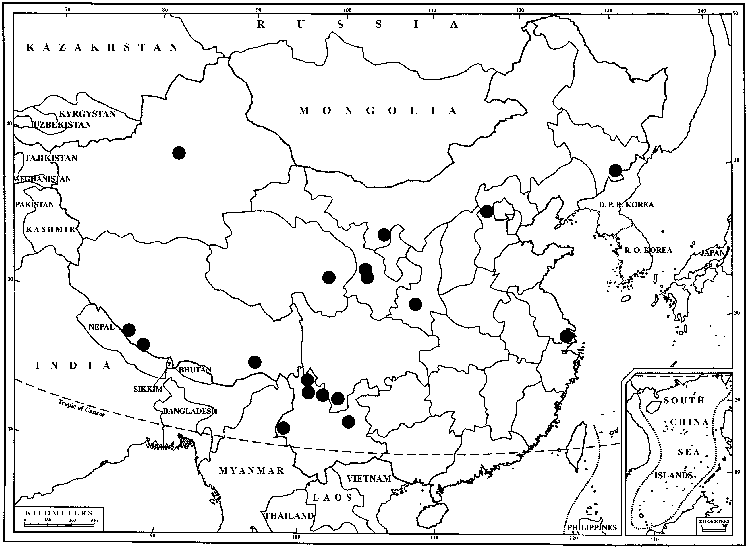Didymodon rigidulus
Sp. Musc. Frond., 104. 1801 (as rigidulum),.
Plants green, often blackish. Stems to 2 cm, central strand present. Stem leaves appressed-incurved to weakly spreading when dry, spreading or not and not keeled when moist, monomorphic, long-ligulate, ovate-lanceolate, elliptic-lanceolate or long-lanceolate, broadly channeled across leaf or occasionally somewhat channeled along costa, 0.8–1.7(–3) mm, base scarcely differentiated to ovate, margins recurved in proximal 1/4–3/4, entire, apex acute to subulate, occasionally fragile; costa percurrent to excurrent as a long, thick, blunt subula, not much widened or tapering through the leaf, not strongly spurred, lacking a bulging adaxial pad of cells, adaxial costal cells quadrate, in (2–)3–4(–5) rows, guide cells in a single layer; basal laminal cells weakly differentiated medially, rectangular, walls thin to evenly thickened, proximal maginal cells little differentiated; distal laminal cells mostly 8–11 µm wide, 1:1, papillae absent or simple or occasionally 2-fid, lumens oval to rounded-quadrate, walls evenly thickened, moderately bulging on both sides or only abaxially, sometimes 2-stratose marginally or at apex of leaf, or throughout lamina. Specialized asexual reproduction by axillary, ovate to elliptic, multicellular gemmae. Seta 0.7–1.7 cm. Capsule 1–2 mm; peristome teeth 32 or 16 cleft to base or rudimentary or occasionally absent, filamentous or long-triangular, straight or weakly twisted, to 740 µm. Spores 9–12 µm. Distal laminal KOH reaction yellow- or red-orange.
Distribution

North America, Mexico, s South America, Eurasia, n Africa.
Discussion
Varieties 6 (5 in the flora).
Didymodon rigidulus in the broad sense, as emended by R. H. Zander (1981b) is polymorphic, with several varieties distinguished by fairly good correlations of combinations of characters. Specimens of intermediate morphology that are not clearly assignable to any one variety may be identified as D. rigidulus in the broad sense. Although some authors use the presence of axillary gemmae as diagnostic of the typical variety, other varieties, notably var. gracilis, may occasionally have them. Such gemmae are also found in other species, especially those of the D. vinealis complex. Didymodon vinealis may have 2-stratose distal laminal cells, and should be carefully distinguished.
Selected References
None.
Lower Taxa
Key
| 1 | Lamina 2-stratose in distal 1/2-3/4 | Didymodon rigidulus var. subulatus |
| 1 | Lamina 1-stratose or 2-stratose only at the extreme leaf apex or on the distal margins | > 2 |
| 2 | Leaves oblong-lanceolate, elliptic-lanceolate or occasionally long-triangular; costa usually short-excurrent and blunt; apex and distal margins generally 2-stratose; gemmae often present | Didymodon rigidulus var. rigidulus |
| 2 | Leaves short-lanceolate to lanceolate; costa percurrent to long-excurrent, usually sharp; distal margins 1-stratose or less commonly 2-stratose in patches; gemmae usually absent | > 3 |
| 3 | Plants flagellate, leaves strongly appressed when dry, linear-lanceolate; costa long-excurrent | Didymodon rigidulus var. ditrichoides |
| 3 | Plants thickly leaved, leaves appressed to spreading when dry, short-lanceolate to long-lanceolate; costa percurrent to long-excurrent | > 4 |
| 4 | Leaves short- to long-lanceolate; base evenly broadened, square or rectangular; costa usually percurrent to short-excurrent as a rigid subula, seldom-excurrent; distal cells generally papillose, oval or rounded-quadrate; proximal cells short-rectangular; gemmae occasionally present | Didymodon rigidulus var. gracilis |
| 4 | Leaves long-lanceolate; base abruptly broadened, ovate; costa usually long-excurrent as a straight or flexuose, often fragile subula; distal cells usually smooth, usually angular; proximal cells usually quadrate; gemmae very rare | Didymodon rigidulus var. icmadophilus |